Author : Barry Thompson
Better by Far
With the outstanding success of the 44V Cruise, you would have expected that the 52V would be just as good. It’s not – it’s better.
Designer Chris Pollock has taken what was already a successful concept with the 44V and surpassed it. “We ticked the boxes on what people wanted and I think we got it right from day one” he says.
The Genesis 52V Cruise is essentially a bigger version of the 44V Cruise but with a very different layout due to the extra volume the bigger boat allows.
Genesis Marine has been building sport cruisers now for 23 years and the name is legendary in boating circles. A few years ago Chris Pollock decided to take a whole new design approach and with the birth of the 44V we saw a lot of the latest European influences coming to the fore. Sliding saloon roofs and non conventional window shapes were just a couple of those ideas.
With the advent of the Volvo Penta IPS drive, he also had the right engine to offer with his ‘radically’ new Genesis. The first 44V was displayed at the 2007 IMTEC boat show in Auckland and since then an impressive 14 have been sold – all with Volvo Penta IPS.
The 52V continues that European theme, with the latest design concepts that have allowed the company to reconfigure the superstructure styling to present a boat with a huge lifestyle advantage. There’s simply more space to enjoy being aboard, with an impressive flow through from the helm to the transom BBQ!
Quiet Achiever
The twin Volvo Penta IPS500s running T3 propellers pull 3500rpm @ just over 31 knots. Cruising on Auckland Harbour in calm seas, the 52V Cruise eats up the miles in quiet haste at 25 knots. I was impressed with the transition from idle to planing mode, with such limited bow angle at any time and a smoothness that is reminiscent of sport boats half its size.
Genesis Marine has encased the engine bay in Soundguard sound insulation and it certainly did the job. Even at maximum rpm with the rear doors open, the sound of the twin engines was at a very low level.
Despite its size the 52V doesn’t mind being ‘tossed’ around. This is not the first IPS boat I have driven and I have found them all much the same – incredibly agile, responsive and easy to drive. Of course, once you get back to the marina, the joystick steering is a ‘must have’ option.
Although based on his Genesis 44V hull design, Chris Pollock has taken the advantage of the extra beam and length of the 52V to produce an even better performing hull. The deadrise is the same, but the planing strake area does not have such a pronounced warped chine as the V44 and is essentially more suited to the IPS drives. However, he says that the hull has also been designed to be fully adaptable to shaft or vee-drive installations.
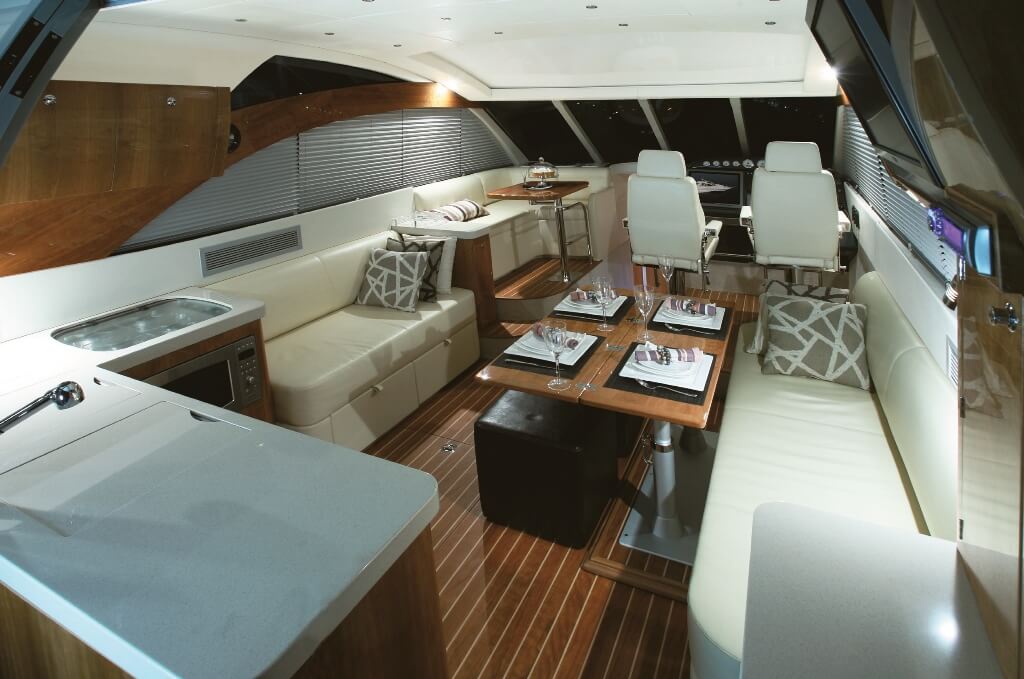
Three Cabins
There is a modern simplicity about the accommodation areas that balances good design with practicality and space. While essentially a production boat, owners do have some flexibility, especially in the accommodation areas.
With the extra internal volume of the 52V Cruise, accommodation areas are generous, with three cabins serviced by two en-suites. For the owners there’s a full beam extra large berth forward, surrounded with overhead storage lockers and twin hanging lockers aft. A couple of small two-seat settees and a flat screen TV complete the generous space.
A Taylor circular opening deck hatch lets in plenty of light and ventilation and is cleverly surrounded with a wood veneer moulding complete with LED lights, this arrangement also houses a blind and mesh screen. The two en-suites are mirror images of each other, with a walk-in shower with glass doors, head complete with secondary hinged seat and Avonite solid surface vanities. The owners’ is accessed from the forward cabin and the shared boat’s head from the companionway.
Guests have the choice of a port side cabin with two very long single berths or a starboard side double that is recessed under the saloon helm. Both provide ample locker and storage space, have excellent lighting from overhead or side hatches and are individually air conditioned. Overall there are dedicated berths for six, plus any overflow can be taken up with the saloon settees.
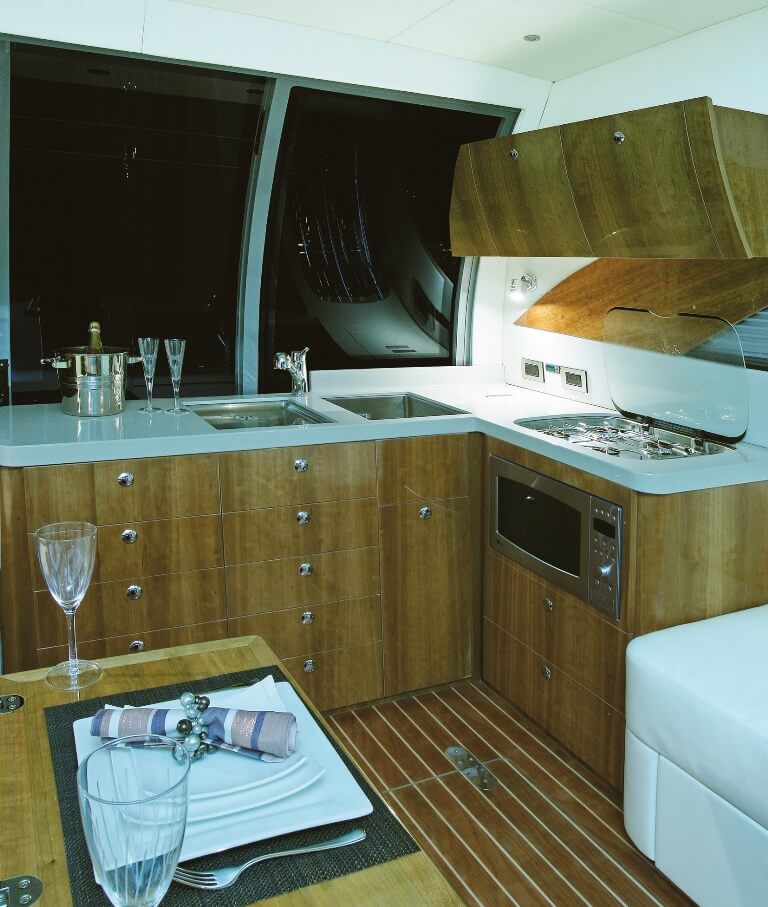
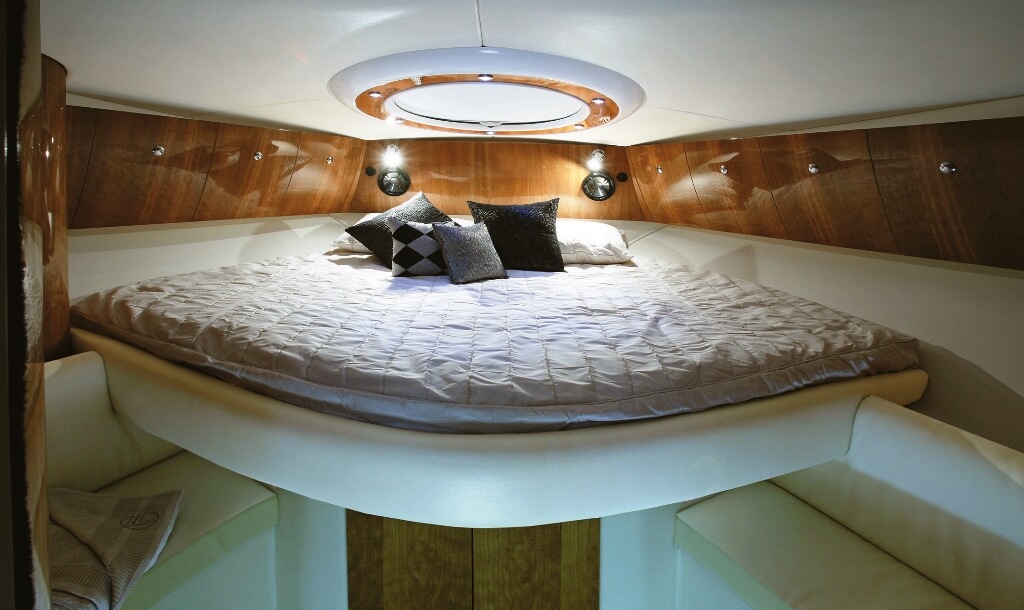
The 52V Cruise is finished throughout in high gloss American cherry veneers and uses powdercoat extruded aluminium door frames with PVC doors. While the internal cabin side of the doors has been left white, the outside has been overlayed with cherry veneer to add some consistency with the rest of the heavily timbered hallway.
Open & Spacious
One of the great features of the 52V is the blend of internal and external spaces. From the moment you walk into the saloon of the 52V Cruise you are overwhelmed by the spaciousness and open feeling. Over generous windows and a full glass rear sliding door accentuate the space.
The saloon has been cleverly broken into four distinctive zones, each merging into the other harmoniously. The forward area is taken up with a starboard side helm. The standard instrumentation display is a Raymarine E120, but on Patricia Mary this was upscaled to a Raymarine Digital G Series with a considerably larger screen. A carbon fibre and fibreglass moulded facia houses all the necessary navigation and engine systems and the driver plus guest are able to sit in the comfort of twin Ultra Leather covered Navigator helm chairs.
As Patricia Mary has been built to 2C Queensland Survey, the full-width two-piece forward screen has been given two extra mullions to comply with the regulations. The standard boat has just one in the centre, leaving expansive viewing opportunities.
Opposite the helm is the raised day lounger complete with swing-in coffee table, with a side settee aft that carries through to the rear galley. I particularly liked the galley layout that is simple in its design and totally sensible. Storage is under the L-shaped Avonite vanity in soft-close drawers, with twin sinks, top loading freezer, convection oven and four-burner gas hob completing the layout. There are also sink drainers and chopping boards designed to fit into the sinks, a nice touch.
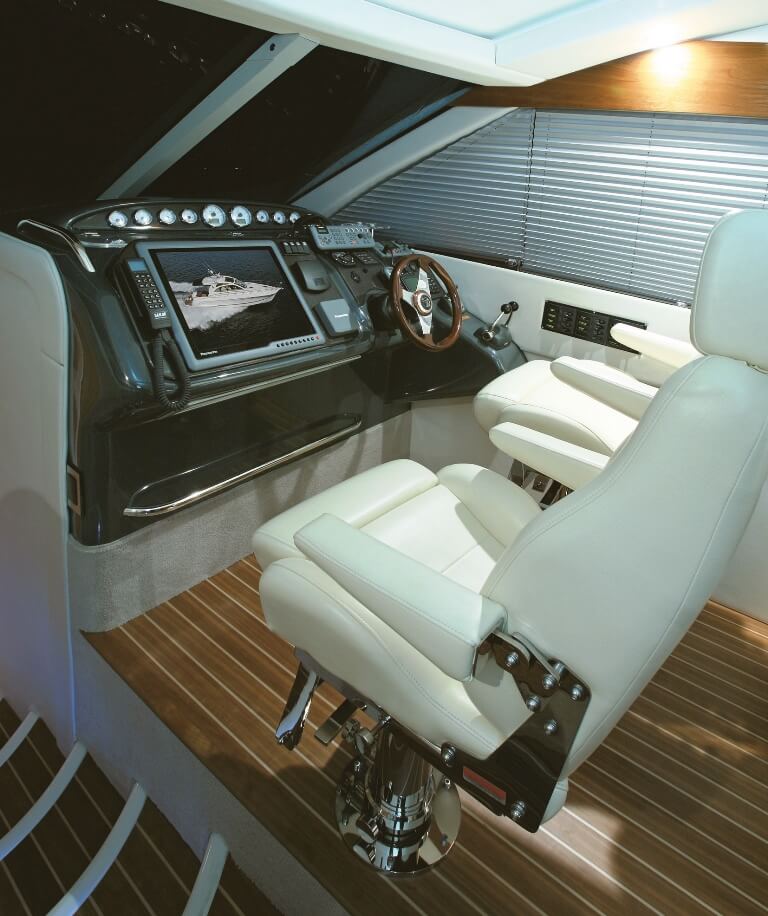
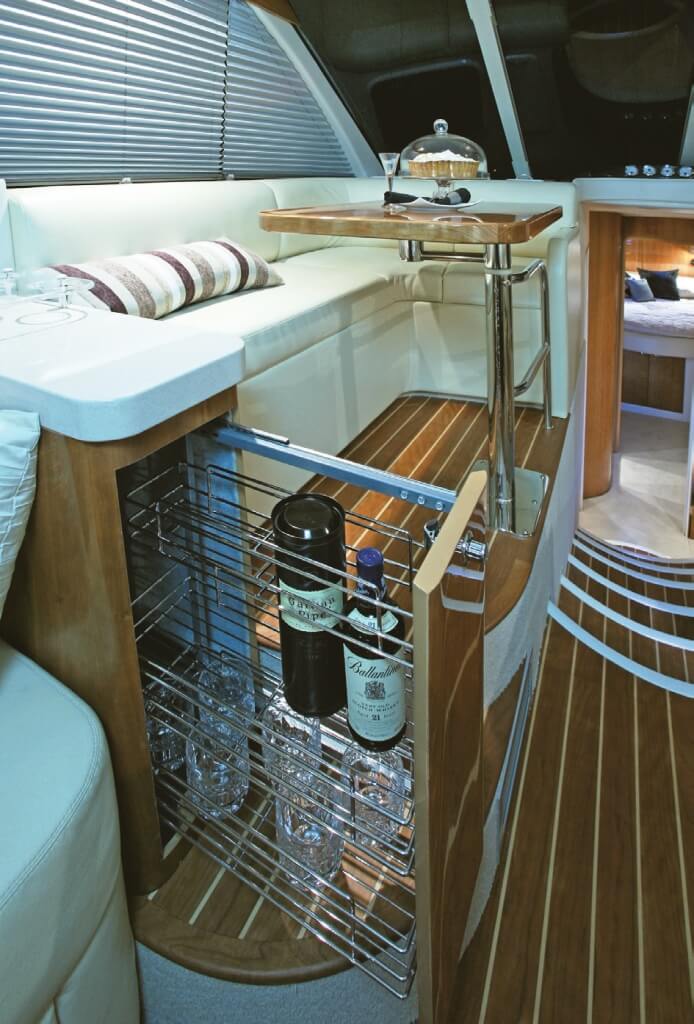
With the rear sliding curved door open, the galley is transformed into an alfresco servery area – again, a nice blend of space that really works.
The starboard side dining table can be folded out to cater for 6-8 guests with the addition of a couple of loose chairs. However, in the folded position, maximum use is made of the saloon space and there is still adequate room for 4-5 around the solid cherry table.
The standard saloon sole is American cherry and holly panelling, plus there is a fully carpeted option available. Should the abundance of light radiating into the saloon need to be decreased or some privacy is called for, Oceanair folding blinds drop down from behind the pelmets. There is also ample mood and direct lighting throughout to add that air of a relaxed ambience at night. Following on from the introduction in the 44V, the 52V also uses a similar electrically operated full sliding sunroof which transforms the boat from a sports targa into a sports convertible.
The next Genesis 52V to be launched will be the first of the Sport versions which has a two-cabin option, with a lower galley and a comprehensive wetbar on the saloon level.
The new 52V Cruise has a very impressive cockpit that makes maximum use of the space. A very solid bright finished inlaid teak table can be complemented with two white circular ottoman type stools The upper cockpit is complete with side lockers, steps to the foredeck, a 1.5m canvas sun shade overhang, plus an optional seating arrangement.
To access the engines the cockpit sole is raised through an electro- mechanical system for all-round access to the engines. With the IPS installation the engines are obviously aft so the normal lazarette space in boats of this size is gone. In this situation the void under the saloon is now used as a storage area and also the home for some of the machinery such as the air conditioning units, battery bank and freshwater cylinder. Genesis has made sure that there is enough height and space available in here to accommodate twin engines on shafts should that option be chosen by a buyer.
The transom is equipped with another large locker, Magma BBQ, sink unit and trash bin. The 1.5m long teak covered boarding platform, which is still part of the hull mould, comes with a couple of wet bins for the fish and as this boat is built to survey and includes some seriously strong stainless rails and gates. Again this is an owner’s choice.
The 52V is a natural progression for current Genesis owners who wish to move up in size. While the smaller sized boats allowed the factory to build up to sixteen boats a year from the West Auckland plant, as the sizes have increased the production capability has moved down accordingly and today the company builds around a boat a month. Once the 52V is established Pollock hopes to sell at least four a year, along with the 44V and the other models in the expanding Genesis range.
It has taken around two and a half years since the 52V was first conceived to see hull#1 in the water and the wait has certainly been worthwhile. Chris Pollock should be justly proud of what he has achieved and as someone who has reviewed every model he has ever built, right from the very first Genesis 3100, this in my opinion is his best ever!
TECHNICAL SPECS
- Design Name: Genesis 52V Cruise
- Boat Name: Patricia Mary
- Builder: Genesis Marine Ltd
- Designer: Chris Pollock
- Interior Designer: Chris Pollock
- Year Launched: 2008
- LOA: 16m
- LWL: 13.05m
- Beam: 4.45m
- Draft: 1.2m
- Displacement: 15000kg
- Max Speed: 31.25 knots
- Cruise Speed: 26 knots
- Fuel Cap: 2000 litres
- Water Cap: 1000 litres
- Construction: GRP
- Engines: 2 x Volvo IPS600 @ 435mhp each




